Photos by Linda Svendsen
Salvage companies still mothball mundane building parts out in a yard, but most warehouse their best architectural antiques in a showroom like the main floor at Omega Lighting & Design in Berkeley.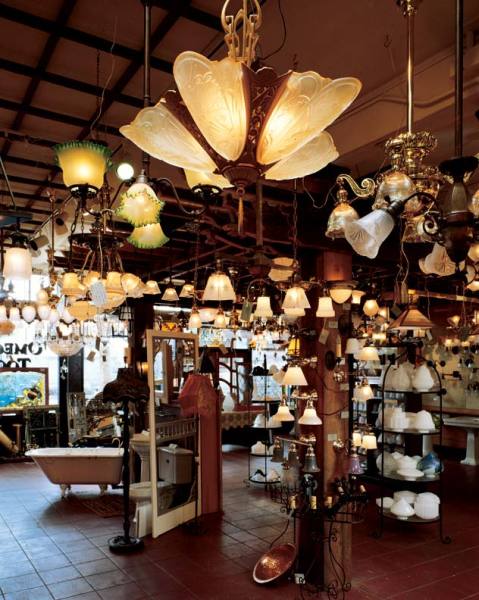
The brass wall sconces in the Queen Anne house down the street are in perfect sync with its age and style. When your neighbor tells you they came from a dealer who specializes in architectural antiques (a.k.a., salvage), you’re ready to start your own search. Whether you want to match common building parts, such as doors and flooring, or replace a lost decorative treasure, like a chandelier or bracket, you can shop the salvage market for reasonably priced, period materials that will enhance the authenticity of any old house.
While some salvage dealers pile the merchandise high and haphazardly, others offer sensibly organized and attractive displays. Go prepared to rummage through the wares until you find that one perfect item. Start by looking under “antiques,” “salvage,” “junk,” or “demolition contractors” in the phone book. Searching locally is more than a matter of convenience. Architectural antiques often have regional idiosyncrasies, so you’re likely to find items common to old houses in your area in a nearby warehouse. Be prepared to spell out exactly what you seek, especially if you’re trying to match a given item. Take sharp, clear pictures or a drawing of the piece with you as you explore salvage yards and shops.
If you’re working long-distance, send an email with a photo. If the product lends itself to shopping by mail, ask the dealer to send samples. Once you’ve found what you’re looking for, talk to the dealer. Even if you think the price is reasonable, don’t accept that as the bottom line. Make him an offer—at least 25 percent less than he has on the tag—and be prepared to back off. If you can buy for 10 or 15 percent less, you’ve got a deal.
Look for columns and posts in sets by style type.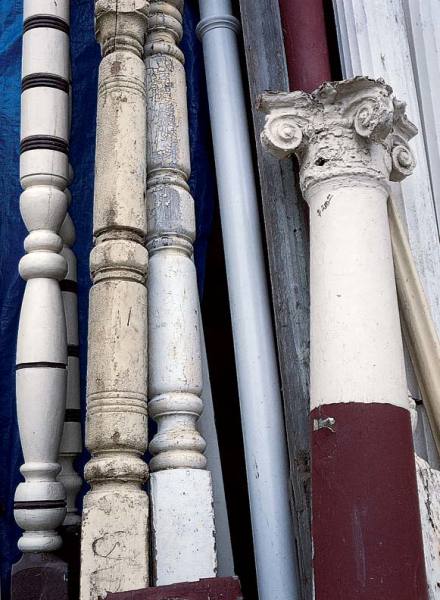
Historic Millwork
Look for columns and posts in sets by style type.
While it’s difficult to find an exact match for an existing stairway or porch railing, you can usually find a close fit. Baluster ends can be either square or round; make sure the salvaged pieces will fit into your treads and handrails the same way. If you need only a few pieces, move the originals to the most visible area and use the salvaged pieces to repair less-prominent places.
If you want to re-create a period staircase or balustrade using salvaged parts, you may have some difficulty meeting modern building codes. “Balusters now have to be less than 4″ apart so that children can’t fall through them, and railings have to be 36″ high,” says Charlie Leone, owner of Collector’s Cove Architectural Antiques in Buffalo, New York. “The old ones are only 32″ high.” Examine architectural millwork carefully, especially if it’s been stored outside. Take a pen knife with you to probe for punky wood, and assume that any painted item is not hiding varnish-quality wood.
A period mantel is likely to have dimensions different from one designed for a modern firebox, so make sure both the outer and inner dimensions correspond to your hearth opening. “Measure from the firebox to the edge of the combustible, which is the wood part of the mantel,” says Bill Raymer, owner of Restoration Resources in Boston. “You need 6″ to 8″ of clearance. If the mantel doesn’t fit and meet code, the building inspector is likely to tell you that you can’t use the fireplace.”
Shopping for mantels and large merchandise is easiest online.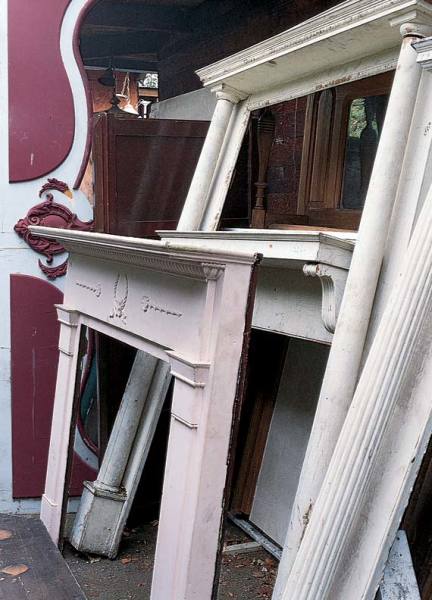
Shopping for mantels and large merchandise is easiest online.
Once you’ve found your mantel, examine it carefully if you intend to strip it. While the ornamental detail may look like carved wood, it could be “compo”—composition ornament, an amalgam of fillers and glue applied to the surface. Any stripping compound will ruin the decoration.
Doors come in all shapes and sizes. Many dealers group them that way. Measure carefully (height x width x thickness) and buy a door sized to your needs. Taking more than 1″ off any edge may substantially weaken the door; even a door 1/4″ thicker than the opening won’t fit. If you’re thinking of stripping a painted or heavily varnished door down to bare wood, proceed cautiously. Lots of old doors were constructed from a patchwork of woods.
Original Lighting
Lighting should run from parts to whole pendants.
If you’re buying an antique lamp, ceiling fixture, wall sconce, or fan, be sure to measure any piece under consideration carefully. “Unless you know the diameter and size, and how it’s going to fit into the room, you can buy a light fixture that looks great in a photo and discover that it’s overpowering or undersized,” says Jordan Michelson, owner of Architectural Salvage W.D., in Louisville, Kentucky.
Lighting should run from parts to whole pendants.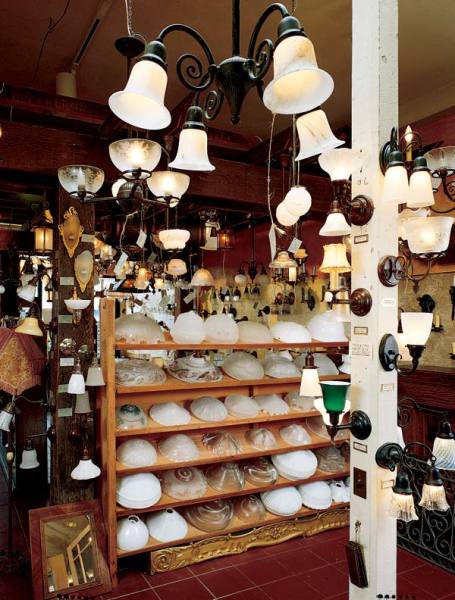
Reproduction lighting fixtures and fans may not have the full heft and charm of the originals, but then they don’t have to be rewired, replated, or taken apart and scrubbed with metal polish. Luckily, many antique lighting specialists will rewire a lamp for you. Have an electrician install vintage ceiling fixtures and fans. If you’ve fallen in love with an old gaslight fixture, remember that converting it to electricity is a job for an expert.
Experienced Flooring
Wide floorboards of pine, chestnut, or other old-growth woods are a wonderful alternative to new hardwoods. Some of the choicest have been salvaged from attics, where they escaped paint, nails, and wear. In the East, the most commonly available woods are white pine, hemlock, spruce, and chestnut. In the West, Douglas fir and redwood are sought after. “Redwood is becoming increasingly rare,” says Mary Lou Shepas, manager of Omega Lighting & Design.
Expect to pay at least $7 a running foot and more for wide, long, beautiful flooring. Shipping can add significantly more to the cost. Experienced dealers may remill the flooring to get rid of imperfections and warps and to make the dimensions consistent. Whether remilled or not, salvaged floor boards should be warp-free. Tongue-and-groove edges should be in good condition. If you are matching an existing floor, select boards of an appropriate thickness, grain pattern, and color.
Bring a ruler for sizing sanitary ware.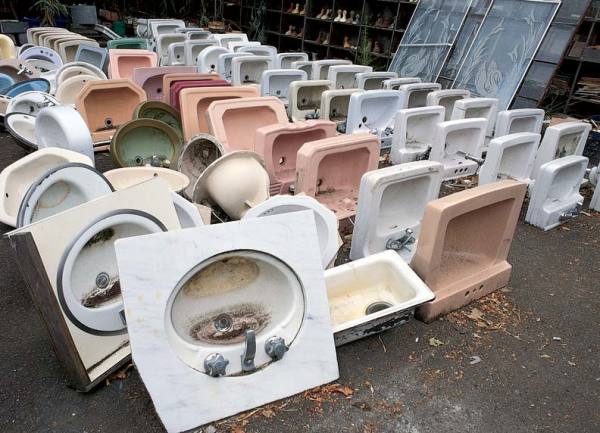
Vintage Plumbing
Old sinks, bathtubs, and even commodes are still sought after, even though reproductions made from the same molds are readily available and almost indistinguishable. “We sell a lot of clawfoot tubs,” says Steve Miller of Hippo Hardware in Portland, Oregon. “When I find an older piece and rebuild it, it moves like flapjacks at a Lion’s Club breakfast.”
Salvage and reproduction pieces are about the same price. Since the spread between hot and cold water faucets is different today, the best buys have the fittings attached. Also, some localities prohibit the reuse of old toilets, or require that only low-flush toilets be installed. Look over any potential purchase carefully. A little crazing may be acceptable, but avoid anything that has a large crack. Radiators are another good buy. A cracked radiator is useless, but a good plumber can fix one that just leaks around the valves. If the radiator has been painted, have it dip-stripped so that the connections are clean.
Antique Glass
While you can find replacement window sash for a vintage house, the older the sash, the less likely it is to be in good condition. Be sure to check that the style and profile of the window muntins is appropriate to your house. Old glass is hard to cut without breakage, so buy more than you need if you’re buying replacement glass. “We sell more stained glass in the summer, when there is a little more light and people can more easily appreciate its beauty,” says Cathy Black, owner of Traders of the Lost Art in Edmonton, Alberta. If you’re considering leaded glass, the simpler patterns are the most reasonably priced. Check the condition of the cames (the lead channels that hold the individual pieces of glass in place) and examine the solder joints. If the glass is sound and any damage to the cames is minor, have a stained glass restoration artisan repair the piece.
Cast iron knocks down readily for shipping.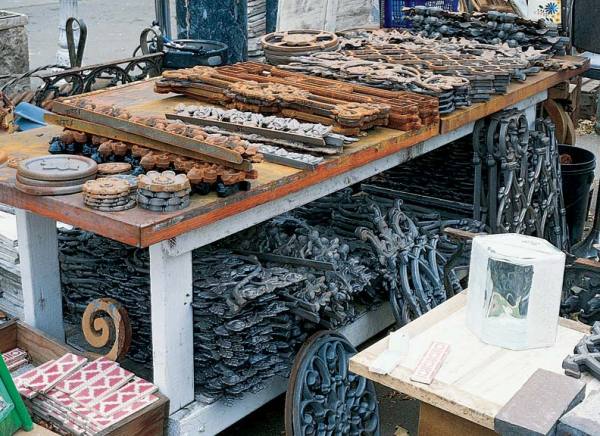
Period Hardware
Cast iron knocks down readily for shipping.
Many dealers sell a wide variety of refurbished hardware with all the fittings you’ll need. “Doorknobs are neat architectural pieces and people can identify with them,” says Tom Joyal, owner of Old House Parts in Kennebunk, Maine. “They can also see themselves putting the knob on the door.” With a little searching, it’s possible to find enough sets to outfit an entire house. Expect to pay a little more for period hardware than for reproduction.
Wrought and cast iron last practically forever. Provided that none of the joints are broken, even heavily rusted metals can be refurbished. All of the rust must be removed before any repairs are made. Either wire brush down to bright metal, or use low-pressure, dry-grit blasting (80 pounds per square inch, with particles 70-100 mesh in size). Auto-body shops will often do this for you cheaply. Once the metal is rust free, the surface should be primed and painted with alkyd rust-inhibitive paints.
Reclaimed Stone & Tile
Expect to find only high quality stone, terra cotta, or carved stone units at architectural salvage yards. Unless there is severe damage, age will only soften and improve old stone, although stained marble will stay that way. “Some people reject anything that’s chipped or hacked off,” says Kevin Browne, manager of Olde Good Things in New York City. “Perfection isn’t always possible. You have to understand that a few hairline cracks and chips just add character.”
Slate or marble in good condition can be adapted for countertops, as can vintage tile. Since it can be difficult to collect enough matching tile for a project, focus on accent pieces to go with new tile, or mix colors of matched salvaged tile. Buy extra to allow for breakage, and avoid tiles with heavy deposits of mortar—it’s hard to remove without breaking the tile.
Rooting through the salvage marketplace isn’t for everyone, but it’s possible to discover rare booty among the dirt and dents. “When I sell something, it is one of a kind,” says Mario Lodato, owner of United House Wrecking in Stamford, Connecticut. “I can only sell it to one person. It tickles me to death when someone goes home with a piece they think is really special.”







